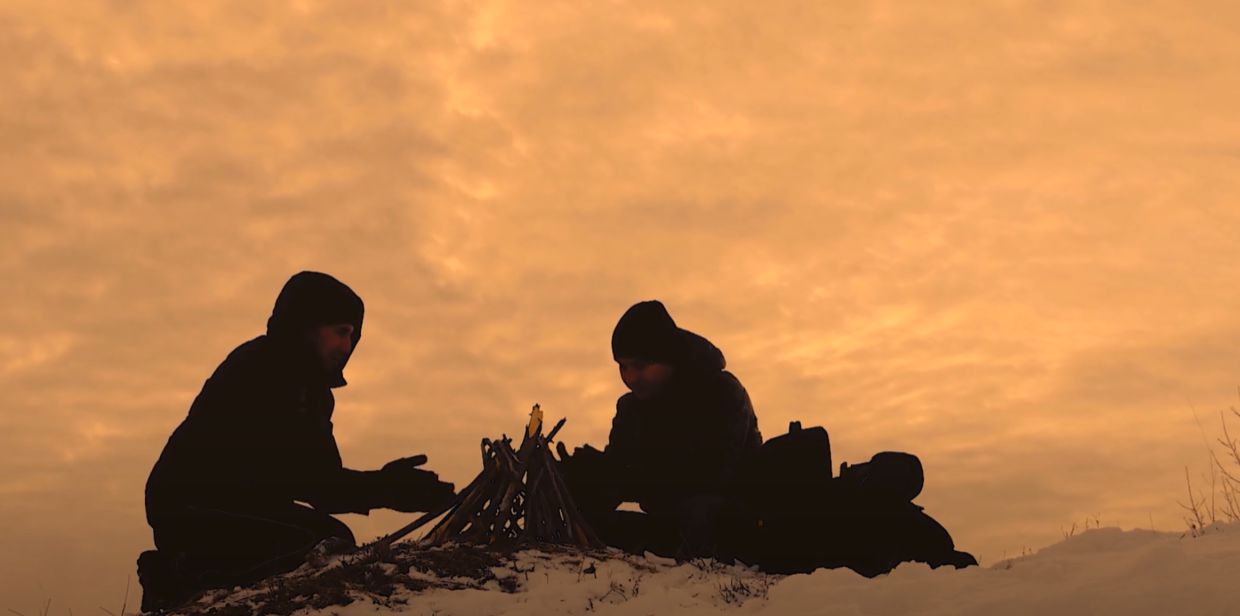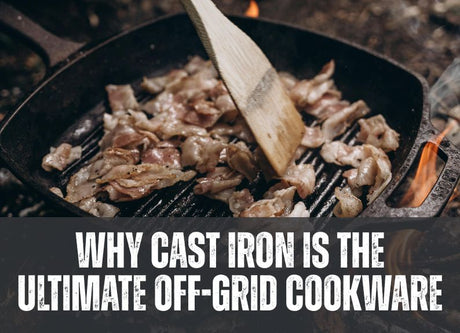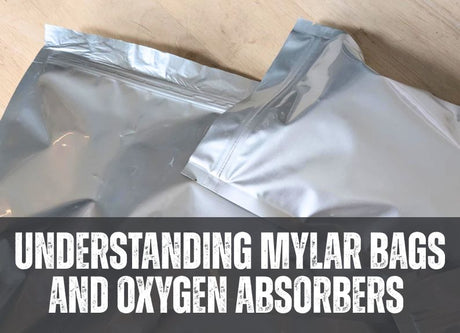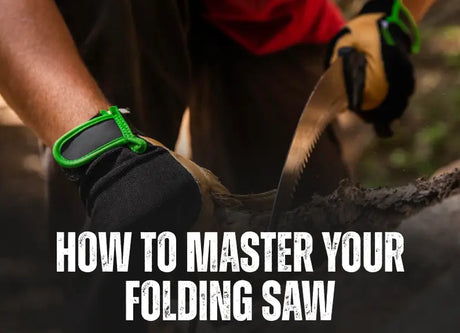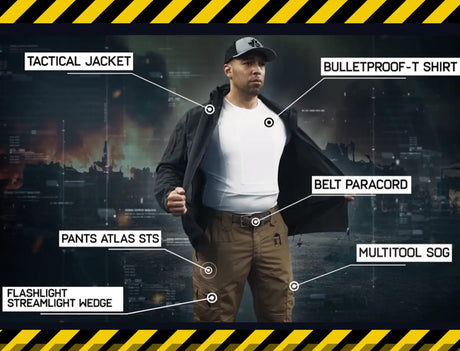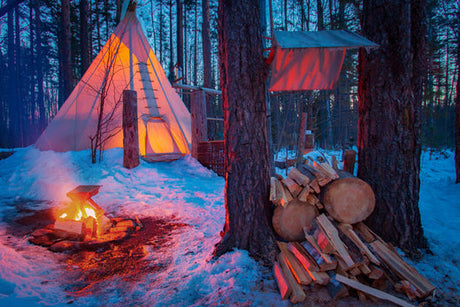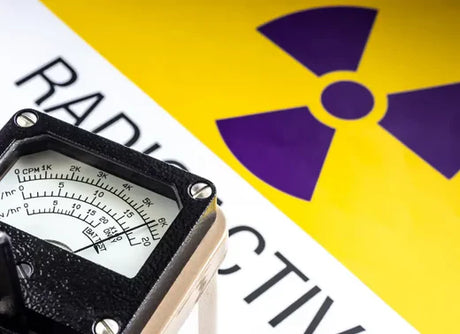In the northern hemisphere, we are routinely subjected to extreme temperatures below -30℃ during our winter months. When we find ourselves in a grid-down scenario, many people are going to die of exposure to the elements as a result of these temperatures. The best way to survive is to be prepared to endure the cold. Winter is a season of scarcity, and for both humans and animals, survival can take a huge toll on your energy reserves. In this blog, we tackle key survival knowledge for some of the most extreme cold temperatures on earth.

Bushcraft survival in extreme environments is about being prepared.
If you live in a climate where extreme winter temperatures are a common fixture, it is imperative that you develop an easy-to-access winter wardrobe and a bug-out kit which includes a sled to carry your gear in a snowy landscape. Your survival depends on having the best and most efficient gear for your needs. In the extreme cold, the smallest error can lead to severe consequences.
 In addition to stocking up on winter essentials, learning how to survive in a cold climate requires practice. Acclimating yourself to winter survival before it becomes a necessity can help you better understand the demands that your environment will impose on you. Organize a winter camping trip with friends to test your abilities in a moderated and relatively low-risk environment. Preparedness is about more than having the materials, it is about learning to use them under the duress of extreme conditions.
In addition to stocking up on winter essentials, learning how to survive in a cold climate requires practice. Acclimating yourself to winter survival before it becomes a necessity can help you better understand the demands that your environment will impose on you. Organize a winter camping trip with friends to test your abilities in a moderated and relatively low-risk environment. Preparedness is about more than having the materials, it is about learning to use them under the duress of extreme conditions.
The ultimate winter bug out bag
Your first extreme cold survival priority is avoiding exposure.
Cold weather is a serious topic. In cold climates, after the natural gas and power grid goes down, many people will die of exposure–that’s just reality in this climate. Understanding how the body reacts to extreme temperatures can help you prioritize tasks to keep you safe. Death from exposure is where your body’s capacity to regulate your temperature fails due to prolonged time in extreme environments. Often, death is a combination of factors such as hypothermia and starvation. The key to your survival in extreme cold temperatures is to prioritize heat, shelter, and food as efficiently as possible.
The human body is designed to maintain a stable temperature, however, this process uses a large number of precious energy stores which must be replenished to prevent death. When your body gets cold, it will restrict the blood flow to your extremities in order to preserve your core temperature. This will prevent you from doing articulated tasks, like using a lighter, so it is crucial to prioritize shelter and warmth as soon as possible. Secondary to shelter is obtaining food, which will replenish your body so that it can keep you warm and alive. Understanding thermogenesis is a key part of understanding why you need to conserve energy and move efficiently in an extremely cold environment.
What is thermogenesis and why is it dangerous?
Thermogenesis is the process of regulating your body’s temperature. In both shivering and non-shivering thermogenesis, your body is attempting to protect your core organs by reducing the heat loss from your extremities and the surface of your skin. Thermoregulation is your body’s built-in method for keeping your most vital organs alive when faced with extremely cold temperatures. Your body will generate heat to preserve your core temperature by burning brown fat, as well as through friction, where your hypothalamus communicates with your muscles to shiver. When you are cold, your body will restrict blood flow to the extremities in order to conserve as much heat for your core as possible; this is called vasoconstriction.
Thermoregulation uses a lot of precious energy so it is destructive if you cannot warm up or replenish your energy fast enough to compensate for the caloric loss. The process of thermogenesis will lead to frostbite, hypothermia, and death as your body depletes its brown fat in order to maintain a stable temperature. The colder it is, the more dangerous this becomes, as it can be harder to warm up and even harder to locate food to replenish your energy in a winter environment. Conserving and prioritizing your energy is a key way to sustain your body in colder temperatures and survival scenarios.
How does circulation affect your ability to stay warm?
In low winter temperatures, your body’s blood vessels and arteries start to constrict. This process of vasoconstriction means that blood flow is restricted and there is less oxygen heading to the heart. As your blood pressure rises, your heart must work harder to supply your body with blood and oxygen. Cold weather causes our circulation to slow causing our hands and feet to become cold and numb. As the body draws blood and warmth towards the vital organs and away from the surface of your skin and surface muscles, your extremities are the first to suffer.
You can keep your hands and feet warm by wearing good waterproof mittens that allow for blood flow and boots that allow you to comfortably add an additional wool sock or sheepskin liner for added warmth. If your feet and hand are constricted, this will make you colder faster, so it’s key that you have well-fitting gear.
The process of thermoregulation can cause extreme stress on someone who already has high blood pressure, so it is necessary to maintain your health to control your blood pressure if you are preparing to survive in the extreme cold. To increase your circulation and tolerance for cold weather, you should start to get outdoors in a controlled way; walking, running, or taking up a winter activity like snow-shoeing or cross country skiing (the equipment needed for these will also be handy in a survival situation). You should also focus on maintaining your fitness and prioritizing your water intake––hydration is a key component in the health and function of your body.
With discipline, you can be prepared for any weather and any survival situation. To learn more read our latest blogs, 9 steps you can every day to prepare for the collapse, and our guide to fitness training for preppers.
How does the cold affect your caloric intake?
In an extreme weather survival setting, a human can expend up to 7,000 calories a day. It takes a lot of energy to keep your body warm. In addition, the work needed to survive is racing and intensive––especially when moving through the snow. It would be incredibly dangerous to assume the energy use you need to survive in the backcountry would be similar to when you sit at your computer desk most of the day; underestimating your needed caloric intake is very dangerous.
In order to generate warmth, your body uses your stored energy. Understanding can help you make important decisions for how to use your precious calories; an hour spent collecting firewood is six hours of warmth. This is why knowing about thermogenesis is so critical to your survival.

In order to replenish your energy efficiently, stockpiling food to help you through the lean cold season is a necessity. Your survival plan must include a comprehensive strategy for gathering and storing foods with a long shelf life. Freeze-dried foods, canning, and powered foods can and will keep you alive throughout the long winter. Preparing and storing your own food or purchasing high-quality emergency foods is an essential homesteading skill that will allow you and your family to survive.
Knowing how to dress is a key part of thriving outdoors in the cold.
Three main factors in dangerous weather dressing are: layers, core protection, and durability.
-
Outdoor Survival Mission jacket & Snow pants
Having the right outer layers to protect you from the elements will go a long way. Down-filled and rugged, these level three (-20 to -50°C / -4 to -58°F) outer garments are tried and tested by us at Canadian Preparedness. To learn more about dressing for extreme temperatures, read our blog. Snow pants are going to be too warm to wear if it is above -20°C/-4°F, but in extreme temperatures, they are going to limit your range of movement but be absolutely necessary for your survival.
-
Animal fur mittens
In extremely cold temperatures, mittens will be superior to gloves as they reduce the surface area for heat loss and they insulate the wearer, which slows the rate of heat transfer to the external environment. You can layer your mittens over a pair of lightweight gloves that allow you more dexterity when needed to maximize your capacity.
-
Boots
The boots that you choose for the cold should be at least a half size larger than your regular footwear to comfortably accommodate wool socks or sheepskin liners without further constricting your blood flow. When you buy a boot with a -30°C/-22°F or below, it’s reasonable to not expect it to perform at its maximum temperature; buying the lowest temperature-rated boot you can is the best method for performance.
-
Merino wool or polypropylene base layers
These layers wick away moisture preventing chill as well as maintain your body temperature as you move and function. Base layers are a critical part of your cold-weather preparedness.
-
Eye protection
The sun can be extremely damaging to our eyes, especially while it reflects off the huge expanse of snow and ice. Having good goggles with lenses that protect your eyes from harmful UVA UVB rays is a key part of your winter wardrobe. In addition, in the extreme cold, your corneas can be subject to freezing, which causes extreme pain and discomfort.
Are animal fibres are necessary for extreme winter dressing?
Fur has been exploited for the sake of fashion, however, being prepared is all about function and necessity. Fur, wool, down, and shearling are all essential ways to preserve heat in extremely cold environments. In our opinion, there is no synthetic garment that is going to keep you alive in sub-arctic temperatures while maintaining dexterity and durability.
You can support sustainable economies by supporting local and indigenous trappers when you are creating a winter arsenal. In addition, gear made from animal fibres that are heirloom quality should last you for a significant period of time. In many cases, animal fibres will outlast you and still continue to be useful.
5 essential items for winter survival on Canadian Preparedness.
-
Portable woodstove
A portable wood-burning stove made of aluminum will be a lightweight addition to your winter bug-out bag. It provides a covered heat source that can also be used as a cooktop and for heating a winter hot tent.
-
Hot tent
Hot tents are the pinnacle in temporary winter shelters. Fitted with a wood stove, a hot tent is enough to help you thrive and light enough to bug out will. Learn more details about hot tents in our blog on winter shelters.
-
Hatchet + Axe
Felling wood and collecting kindling will be a key priority for winter survival. Before you have to survive, learn about the 6 main types of fires for winter survival. Understanding the labour needed to build a fire and collect wood can help you understand and prioritize your energy in an extreme weather environment.
-
Firestarter
There are a number of styles of firestarters available, but when your dexterity is compromised due to extreme temperatures, you don’t want to be trying to light a fire like a boy scout. Having several firestarter options in your bug-out bag can ensure you’re prepared.
-
Freeze-dried foods and MREs
Lightweight and easy to pack, these meals provide the necessary nutrients and carbs for an active body. You can prepare for extreme temperature survival by having a stockpile of foods that can be easily prepared. This saves energy and allows you to supplement your hunting and gathering during a lean season.
Shelter is a critical component of bugging out successfully in winter.
The wind chill is a significant risk factor for survivalists, as it greatly increases the rate of heat loss. As your body thermoregulates, it begins to lose heat from the hands, feet, and surface of exposed skin. Building or finding shelter should be one of your top priorities in outdoor survival but this is especially the case in temperatures below freezing. Whether you construct a shelter from your available natural resources (such as snow and branches) or bring a shelter such as a hot tent (which we highly recommend), getting out of the wind is a necessity.
Your body loses heat through four main avenues:
-
Radiation

When your body temperature is higher than the temperature of the environment, your body will start to lose heat through radiation. A body can lose up to 65% of its heat through this process. To prevent radiation heat loss, you must carefully consider both your winter garments and the ambient temperature of your shelter. Having adequate protection from the wind and cold will prevent death from exposure as well as combat the effects of thermoregulation.
-
Conduction

This is most dangerous when the body is wet, which can be caused by sweating, humidity, walking through snow, or falling through the ice. Water causes significantly higher heat loss than air, so preventing wetness in the cold is a survivalist’s top priority. Ensure you choose wicking base layers to remove moisture from your body safely and efficiently.
Heat loss from conduction can also occur when the body is in the snow, especially when sleeping directly on the ground. Adding a cot as well as a thick wool blanket to your bug-out bag will keep you warmer and stave off hypothermia, thermogenesis, or death.
-
Convection:

This is why having a shelter is so critical to your survival. The body can lose up to 15% of its heat from being exposed to wind (which is why a fan in the summer can be effective). In the winter, where you need to preserve every precious bit of heat, this can be extremely dangerous. Removing yourself from the direct force of the elements will help you stay warm.
-
Evaporation:

Wicking base layers will keep your body dry and will prevent evaporation from occurring. Evaporation can cause you to cool down rapidly, so it is important for your safety to stay comfortable and dry.
Outdoor winter survival is about setting priorities and being prepared.
When you prepare for the worst you have a better chance of survival. In intensely cold temperatures, your ability to survive requires practice and discipline. If you live in an area of the world where extreme cold weather is common, we know these tips will help you live.

